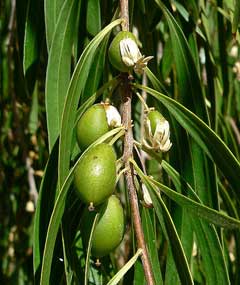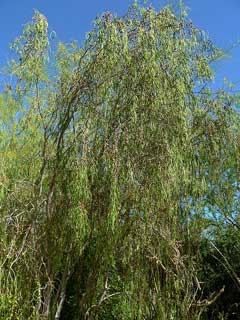 |
|
http://commons.wikimedia.org/wiki/User:Stan_Shebs |
 |
| http://commons.wikimedia.org/wiki/User:Stan_Shebs |
Translate this page:
Summary
Bloom Color: White. Main Bloom Time: Early spring, Late spring, Mid spring. Form: Rounded, Vase, Weeping.
Physical Characteristics

 Pittosporum phillyreoides is an evergreen Shrub growing to 4.5 m (14ft 9in) at a slow rate.
Pittosporum phillyreoides is an evergreen Shrub growing to 4.5 m (14ft 9in) at a slow rate.
See above for USDA hardiness. It is hardy to UK zone 9. It is in leaf all year. The species is hermaphrodite (has both male and female organs).
Suitable for: light (sandy) and medium (loamy) soils and prefers well-drained soil. Suitable pH: mildly acid, neutral and basic (mildly alkaline) soils. It cannot grow in the shade. It prefers dry or moist soil and can tolerate drought.
UK Hardiness Map
US Hardiness Map
Synonyms
P. angustifolium.
Plant Habitats
Woodland Garden Sunny Edge; Dappled Shade;
Edible Uses
Edible Parts: Seed
Edible Uses: Gum
Seed - dried and ground into a powder[61, 105, 173]. Very bitter[46, 144, 193]. A good edible gum is obtained from this plant[144, 173]. It oozes from wounded branches[193].
References More on Edible Uses
Medicinal Uses
Plants For A Future can not take any responsibility for any adverse effects from the use of plants. Always seek advice from a professional before using a plant medicinally.
Antipruritic Antispasmodic Eczema Galactogogue
Antispasmodic, antipruritic, galactogogue. Used in the treatment of eczema, pruritis and colds.
References More on Medicinal Uses
The Bookshop: Edible Plant Books
Our Latest books on Perennial Plants For Food Forests and Permaculture Gardens in paperback or digital formats.

Edible Tropical Plants
Food Forest Plants for Hotter Conditions: 250+ Plants For Tropical Food Forests & Permaculture Gardens.
More

Edible Temperate Plants
Plants for Your Food Forest: 500 Plants for Temperate Food Forests & Permaculture Gardens.
More

More Books
PFAF have eight books available in paperback and digital formats. Browse the shop for more information.
Shop Now
Other Uses
Gum Repellent Soap Wood
The plant contains saponins. These have the potential to be used as soap or as a bird repellent. Since they are very bitter they can be sprayed over plants that you do not want the birds to eat. The saponins are easily removed by washing or the next rain shower. Wood - close grained, very hard. Used for turnery, cabinet making etc[154].
Special Uses
References More on Other Uses
Cultivation details
Landscape Uses:Border, Container, Massing, Screen, Standard, Seashore, Specimen, Street treeRequires a well-drained light loamy soil, succeeding in very dry soils[11, 167]. Requires a sunny position[200]. Plants tolerate much wetter conditions in cultivation than they experience in their native habitat[167]. Not very hardy in Britain, tolerating temperatures down to about -5°c[200]. Plants succeed outdoors in Cornwall though they need greenhouse protection in other parts of the country[1]. A slow growing plant[167]. Very amenable to pruning, plants can be cut right back into old wood if required[200]. The species in this genus are very likely to hybridize with other members of the genus[200]. When growing a species from seed it is important to ensure that the seed either comes from a known wild source, or from isolated specimens in cultivation. Plants in this genus are notably resistant to honey fungus[200]. Special Features:
Attractive foliage, Not North American native, Fragrant flowers, Attractive flowers or blooms.
References Carbon Farming Information and Carbon Sequestration Information
Temperature Converter
Type a value in the Celsius field to convert the value to Fahrenheit:
Fahrenheit:
The PFAF Bookshop
Plants For A Future have a number of books available in paperback and digital form. Book titles include Edible Plants, Edible Perennials, Edible Trees,Edible Shrubs, Woodland Gardening, and Temperate Food Forest Plants. Our new book is Food Forest Plants For Hotter Conditions (Tropical and Sub-Tropical).
Shop Now
Plant Propagation
Seed - sow when ripe in the autumn or in late winter in a warm greenhouse[78, 200]. The seed usually germinates freely. Prick out the seedlings into individual pots when they are large enough to handle, move the plants to a cold frame as soon as they are established and plant out late in the following spring[78]. Consider giving them some protection from the cold during their first winter outdoors. Cuttings of half-ripe wood, 5 - 7cm with a heel, July/August in a frame. Poor to fair percentage[78]. Basal ripewood cuttings late autumn in a cold frame[200].
Other Names
If available other names are mentioned here
Native Range
AUSTRALASIA: Australia (Western Australia (w.-c.))
Weed Potential
Right plant wrong place. We are currently updating this section.
Please note that a plant may be invasive in one area but may not in your area so it's worth checking.
Conservation Status
IUCN Red List of Threatened Plants Status :

| Related Plants
|
| Latin Name | Common Name | Habit | Height | Hardiness | Growth | Soil | Shade | Moisture | Edible | Medicinal | Other |
| Pittosporum balansae | | Shrub | 3.0 |
-
| | LMH | SN | DM | 1 | 0 | |
| Pittosporum bicolor | Banyalla | Shrub | 5.0 |
8-11
| | LMH | SN | DM | 0 | 0 | 3 |
| Pittosporum crassifolium | Karo, Stiffleaf cheesewood | Shrub | 5.0 |
8-11
| | LM | SN | DM | 0 | 0 | 3 |
| Pittosporum eugenioides | Tarata | Tree | 10.0 |
8-11
| | LM | SN | DM | 1 | 1 | 1 |
| Pittosporum ralphii | Ralph's desertwillow | Shrub | 4.0 |
8-11
| | LM | N | DM | 0 | 0 | 3 |
| Pittosporum resiniferum | Petroleum nut | Tree | 25.0 |
10-12
| M | LMH | N | M | 0 | 3 | 4 |
| Pittosporum tenuifolium | Tawhiwhi | Tree | 7.0 |
7-10
| M | LM | SN | DM | 2 | 0 | 3 |
| Pittosporum tobira | Tobira, Japanese cheesewood, Australian Laurel, Mock Orange, Japanese Pittosporum | Shrub | 6.0 |
8-11
| F | LM | SN | DM | 0 | 0 | 3 |
| Pittosporum undulatum | Cheesewood, Australian cheesewood, Cheesewood, Pittosporum, Orange Berry Pittosporum, Victorian Box | Tree | 12.0 |
9-11
| F | LM | SN | DM | 0 | 0 | 3 |
|
Growth: S = slow M = medium F = fast. Soil: L = light (sandy) M = medium H = heavy (clay). pH: A = acid N = neutral B = basic (alkaline). Shade: F = full shade S = semi-shade N = no shade. Moisture: D = dry M = Moist We = wet Wa = water.
Now available:
Food Forest Plants for Mediterranean Conditions
350+ Perennial Plants For Mediterranean and Drier Food Forests and Permaculture Gardens.
[Paperback and eBook]
This is the third in Plants For A Future's series of plant guides for food forests tailored to
specific climate zones. Following volumes on temperate and tropical ecosystems, this book focuses
on species suited to Mediterranean conditions—regions with hot, dry summers and cool, wet winters,
often facing the added challenge of climate change.
Read More
Expert comment
Author
DC.
Botanical References
11200
Links / References
For a list of references used on this page please go here
Readers comment
| Add a comment |
|
If you have important information about this plant that may help other users please add a comment or link below. Only comments or links that are felt to be directly relevant to a plant will be included. If you think a comment/link or information contained on this page is inaccurate or misleading we would welcome your feedback at [email protected]. If you have questions about a plant please use the Forum on this website as we do not have the resources to answer questions ourselves.
* Please note: the comments by website users are not necessarily those held by PFAF and may give misleading or inaccurate information.
To leave a comment please Register or login here All comments need to be approved so will not appear immediately.
|
Subject : Pittosporum phillyreoides
|
|
|
|